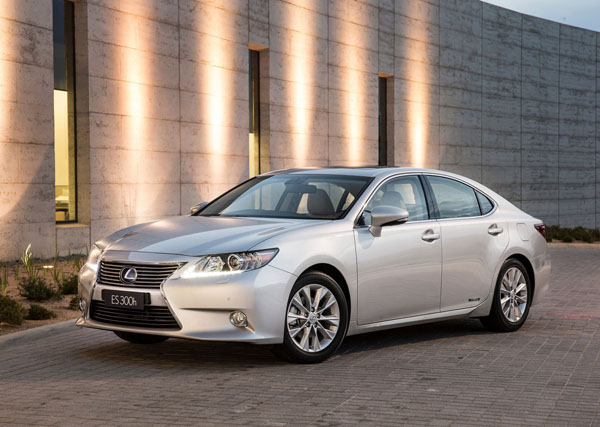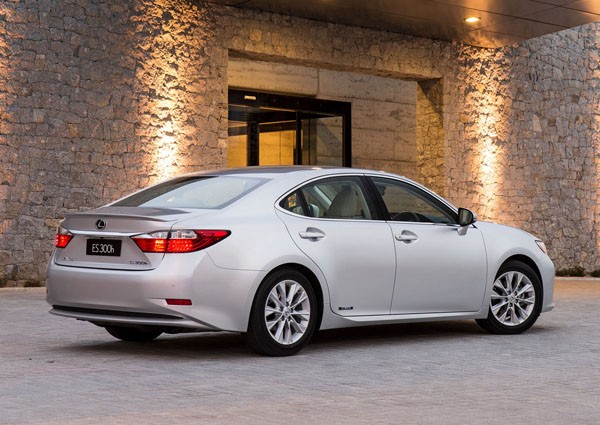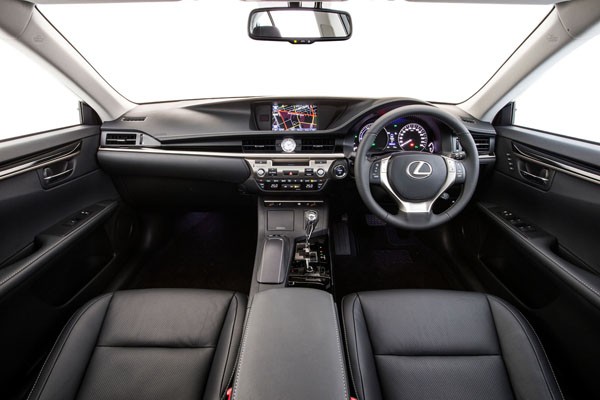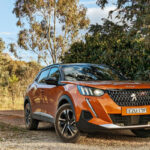
There’s no better way to road test a car than to live with it for an extended period, rather than our usual single week. So we borrowed a Lexus ES 300h for a longterm test, planning to pay particular emphasis to its petrol/electric hybrid system. The small ‘h’ in any Lexus model indicates the use of a hybrid powertrain.
Each model in the all-new Lexus ES line comes in two specification levels, Luxury and Sports Luxury, the latter adding $9000 to the price of both the petrol-only ES 350 with its 3.5-litre V6, and four-cylinder-plus-electric E 300h in Luxury format.
 To stimulate interest in the alternative powerplants, the two ES hybrids are $2000 cheaper than the equivalent non-hybrid petrol V6s although some equipment has been cut from the hybrid with the aim of meeting Lexus’s target of a 50/50 sales split between V6 and hybrid models. Our car for the extended test was priced at $63,000, plus on-road costs.
To stimulate interest in the alternative powerplants, the two ES hybrids are $2000 cheaper than the equivalent non-hybrid petrol V6s although some equipment has been cut from the hybrid with the aim of meeting Lexus’s target of a 50/50 sales split between V6 and hybrid models. Our car for the extended test was priced at $63,000, plus on-road costs.
Unusually, our test car for the past eight weeks has been the lowest priced car in the ES line, the hybrid in Luxury trim. We say ‘unusually’ because it’s common for car companies to give us topline line variants to try and create the best impression. Hopefully us old stagers don’t fall for that one…
 STYLING
STYLING
The latest Lexus ES range follows the signature ‘arrow-head spindle-grille’ theme also seen in other new or facelifted models in the topline Japanese marque’s recent range.
The ES 300h has projector-style halogen headlamps and DRLs (daytime running lights) that give it a distinctive front. Apart from badging the only visual difference between the petrol and hybrid ES models is a small spoiler on the rear of the bootlid of the ES 300h to aid airflow.
The interior is a work of art, with flowing lines finished in hand-stitched leather and wood. We particularly like the olde-fashioned analog-look clock that takes pride of place in the centre of the dash.
ENGINES / TRANSMISSIONS
The Lexus ES 300h combines a 2.5-litre Atkinson cycle four-cylinder petrol engine with nickel-metal-hydride batteries to provide up to 151 kW, and 213 Nm at 4500 rpm as well as the extra efficiency of a continuously variable transmission (CVT).
SAFETY
Standard features in all ES variants include ten airbags; ABS brakes with electronic brakeforce distribution, brake assist and emergency braking signal; stability and traction control; pedestrian protection system; tyre pressure warning; blind spot monitoring; hill-start assist; parking sensors; and rear vision camera.
Optional in the ES 300h Luxury and standard in the other three models is the Lexus Pre-Collision Safety (PCS) system that combines active and passive safety features that send out beeps and hazard light flashing when a crash appears imminent and then applies emergency braking if the driver hasn’t down so.
INFOTAINMENT
Standard across the range are satellite navigation; Mark Levinson 15-speaker Premium Surround Sound System; Bluetooth telephone and audio streaming; USB and Auxiliary sockets; and 3.5-inch full colour multi-information display.
The controls are well-placed and easy to use with a nice smooth feeling that oozes quality.
When we first drove the new Lexus ES line at its launch we commented on the rectangular ‘mouse’ controller, saying we found it far too light in its movements, almost dangerously so if there isn’t a front seat passenger to operate it. Spending extra time with the mouse has made it slightly easier to use as be became accustomed to it, but it’s still too distracting if the driver is tempted to use it while (sort of) paying attention to the road.
DRIVING
New Lexus ES impress with their super-quiet interiors and beautifully smooth ride. The seats are soft but support reasonably well. Rear legroom is good and the hybrid can carry four adults with ease. Likewise, rear seat headroom is fine for all but the tallest of occupants.
The ES hybrid is beautiful in motorway cruising, purring along in an effortless manner that makes long distance travel a breeze. However, hybrids are at their best in stop-start city and suburban commuting, not in steady state touring.
The biggest advantage of any hybrid is regenerative braking. The ES 300h uses its electric drive motor as a generator when slowing down and in particular when braking. At the bottom of a long hill it seems unnatural that the indicated distance to empty is significantly longer than it was at the top.
That’s because the Lexus has used gravity to supply electricity to the battery – that’s as close as something for nothing that you will ever get in a car.
The petrol engine turns off when the ES is stationary. Many other cars, especially European ones, do that nowadays, but the big electric drive motor on the Lexus means the petrol engine starts unobtrusively. Which is more than can be said of many cars with a conventional drivetrain and a stop-start system.
The CVT automatic transmission works extremely well with the instant torque that the electric motor supplies. The Lexus ES 300h doesn’t have the most powerful drivetrain in its class, but it makes excellent use of the power it does have and performs well above its weight.
Official fuel consumption from the ES 300h is rated at 5.5 litres per 100 kilometres. Fuel consumption during our extended test averaged 6.2 litres per hundred kilometres during a combination of motorway, suburban and city driving. Our best was 5.9 litres per hundred during a lot of long distance running, around town it was typically in the 6.7 to 7.2 litre range.
There’s an Eco mode if you’re striving to get the very best from the Lexus, but we found its performance sluggish and not particularly pleasant. The Normal setting is far more usable and though we tried Sport a couple of times we felt there was no real need to use it.
Handling is softer than we like as driving enthusiasts, but there’s plenty of road grip and the midsize Lexus is safe at speeds much higher than would be attempted by the typical owner. Lexus ES owners are looking for luxury cruising rather than driving excitement and the car provides that magnificently.
SUMMING UP
This medium-large Lexus hybrid is easy to live with, drives nicely and consumes petrol at a modest rate. It’s particularly pleasing to drive around town as it’s silent when stationary and smooth and sophisticated when on the move.
AT A GLANCE
MODEL RANGE
ES 300h Luxury 2.5-litre petrol / electric hybrid four-door sedan: $63,000 (CVT automatic)
ES 300h Sports Luxury 2.5-litre petrol / electric hybrid four-door sedan: $72,000 (CVT automatic)
ES 350 Luxury 3.5-litre petrol four-door sedan: $65,000 (six-speed automatic)
ES 350 Sports Luxury 3.5-litre petrol four-door sedan: $74,000 (six-speed automatic)
Note: These prices do not include government or dealer delivery charges. Contact your local Lexus dealer for driveaway prices.
FEATURES
ABS Brakes: Standard in all models
Automatic Transmission: CVT standard in all models
Cruise Control: Standard in all models
Dual Front Airbags: Standard in all models
Front Side Airbags: Standard in all models
Electronic Stability Program: Standard in all models
Rear Parking Sensors: Standard in all models
Reversing Camera: Standard in all models
USB/Auxiliary Audio Inputs: Standard in all models
Bluetooth: Standard in all models
Steering Wheel Mounted Controls: Standard in all models
SPECIFICATIONS (Lexus ES 300h Luxury 2.5-litre petrol / electric hybrid four-door sedan:)
ENGINE
Engine Capacity: 2.494 litres
Configuration: Four cylinders in line
Head Design: DOHC, four valves per cylinder
Compression Ratio: 12.5:1
Bore/Stroke: 90.0 x 98.0 mm
Maximum Power: 118 kW @ 5700 rpm (151 kW combined)
Maximum Torque: 213 Nm @ 4500 rpm
DRIVETRAIN
Driven Wheels: Front
Manual Transmission: Not offered
Automatic Transmission: CVT
Final Drive Ratio: Not applicable
DIMENSIONS, WEIGHT AND CAPACITIES:
Length: 4900 mm
Wheelbase: 2820 mm
Width: 1820 mm
Height: 1450 mm
Turning Circle: 11.4 metres
Kerb Mass: 1685-1705 kg
Fuel Tank Capacity: 65 litres
Boot Capacity: 425 litres
SUSPENSION AND BRAKES:
Front Suspension: Double wishbone, coil springs, gas-pressurised dampers
Rear Suspension: Independent, multi-link, coil springs and dampers
Front Brakes: Ventilated disc
Rear Brakes: Disc
PEFORMANCE:
0-100 km/h Acceleration: 8.5 seconds
FUEL CONSUMPTION:
Fuel Type: Petrol 95RON
Fuel Consumption – Combined Cycle (ADR 81/02): 5.5 L/100 km
GREEN VEHICLE GUIDE RATINGS:
Greenhouse Rating: 8/10
Air Pollution Rating: 8.5/10
STANDARD WARRANTY:
Four years/100,000 km











